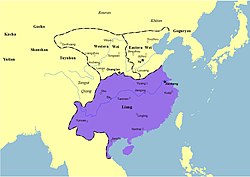Liang 梁 | |||||||||||||||
|---|---|---|---|---|---|---|---|---|---|---|---|---|---|---|---|
| 502–557 | |||||||||||||||
 Liang alongside Western Wei and Eastern Wei after 534. | |||||||||||||||
| Capital | Jiankang (502–552, 555–557) Jiangling (552–555) | ||||||||||||||
| Government | Monarchy | ||||||||||||||
| Emperor | |||||||||||||||
• 502–549 | Emperor Wu of Liang | ||||||||||||||
• 549–551 | Emperor Jianwen of Liang | ||||||||||||||
• 552–555 | Emperor Yuan of Liang | ||||||||||||||
• 555–557 | Emperor Jing of Liang | ||||||||||||||
| History | |||||||||||||||
• Established | 30 April[1] 502 | ||||||||||||||
| 24 April 549[2] | |||||||||||||||
• Jiangling's fall to Western Wei | 7 January 555[3] | ||||||||||||||
• Emperor Jing's yielding the throne to Chen Baxian | 16 November 557 | ||||||||||||||
• Disestablished | 16 November 557 | ||||||||||||||
| Currency | Chinese cash coins (Taiqing Fengle cash coins) | ||||||||||||||
| |||||||||||||||
| Today part of | China Vietnam | ||||||||||||||
| Part of a series on the |
| History of China |
|---|
The Liang dynasty (Chinese: 梁朝; pinyin: Liáng Cháo), alternatively known as the Southern Liang (Chinese: 南梁; pinyin: Nán Liáng) or Xiao Liang (Chinese: 萧梁; pinyin: Xiāo Liáng) in historiography, was an imperial dynasty of China and the third of the four Southern dynasties during the Northern and Southern dynasties period. It was preceded by the Southern Qi dynasty and succeeded by the Chen dynasty. The rump state of Western Liang existed until it was conquered in 587 by the Sui dynasty.
- ^ Zizhi Tongjian, vol. 145.
- ^ Zizhi Tongjian, vol. 162.
- ^ Book of Liang, vol. 5.